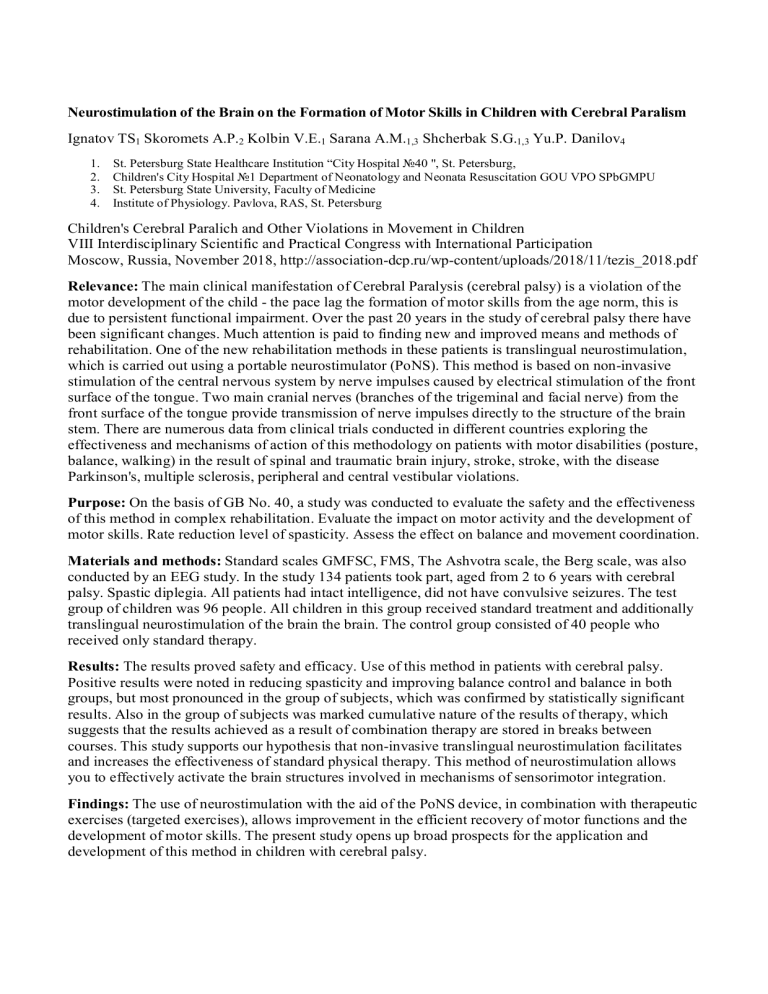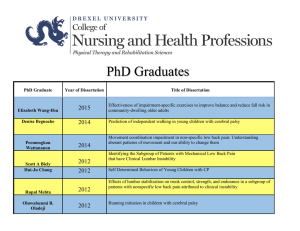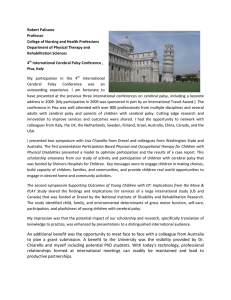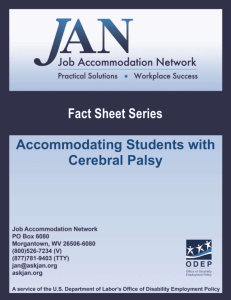
Neurostimulation of the Brain on the Formation of Motor Skills in Children with Cerebral Paralism Ignatov TS1 Skoromets A.P.2 Kolbin V.E.1 Sarana A.M.1,3 Shcherbak S.G.1,3 Yu.P. Danilov4 1. 2. 3. 4. St. Petersburg State Healthcare Institution “City Hospital №40 ", St. Petersburg, Children's City Hospital №1 Department of Neonatology and Neonata Resuscitation GOU VPO SPbGMPU St. Petersburg State University, Faculty of Medicine Institute of Physiology. Pavlova, RAS, St. Petersburg Children's Cerebral Paralich and Other Violations in Movement in Children VIII Interdisciplinary Scientific and Practical Congress with International Participation Moscow, Russia, November 2018, http://association-dcp.ru/wp-content/uploads/2018/11/tezis_2018.pdf Relevance: The main clinical manifestation of Cerebral Paralysis (cerebral palsy) is a violation of the motor development of the child - the pace lag the formation of motor skills from the age norm, this is due to persistent functional impairment. Over the past 20 years in the study of cerebral palsy there have been significant changes. Much attention is paid to finding new and improved means and methods of rehabilitation. One of the new rehabilitation methods in these patients is translingual neurostimulation, which is carried out using a portable neurostimulator (PoNS). This method is based on non-invasive stimulation of the central nervous system by nerve impulses caused by electrical stimulation of the front surface of the tongue. Two main cranial nerves (branches of the trigeminal and facial nerve) from the front surface of the tongue provide transmission of nerve impulses directly to the structure of the brain stem. There are numerous data from clinical trials conducted in different countries exploring the effectiveness and mechanisms of action of this methodology on patients with motor disabilities (posture, balance, walking) in the result of spinal and traumatic brain injury, stroke, stroke, with the disease Parkinson's, multiple sclerosis, peripheral and central vestibular violations. Purpose: On the basis of GB No. 40, a study was conducted to evaluate the safety and the effectiveness of this method in complex rehabilitation. Evaluate the impact on motor activity and the development of motor skills. Rate reduction level of spasticity. Assess the effect on balance and movement coordination. Materials and methods: Standard scales GMFSC, FMS, The Ashvotra scale, the Berg scale, was also conducted by an EEG study. In the study 134 patients took part, aged from 2 to 6 years with cerebral palsy. Spastic diplegia. All patients had intact intelligence, did not have convulsive seizures. The test group of children was 96 people. All children in this group received standard treatment and additionally translingual neurostimulation of the brain the brain. The control group consisted of 40 people who received only standard therapy. Results: The results proved safety and efficacy. Use of this method in patients with cerebral palsy. Positive results were noted in reducing spasticity and improving balance control and balance in both groups, but most pronounced in the group of subjects, which was confirmed by statistically significant results. Also in the group of subjects was marked cumulative nature of the results of therapy, which suggests that the results achieved as a result of combination therapy are stored in breaks between courses. This study supports our hypothesis that non-invasive translingual neurostimulation facilitates and increases the effectiveness of standard physical therapy. This method of neurostimulation allows you to effectively activate the brain structures involved in mechanisms of sensorimotor integration. Findings: The use of neurostimulation with the aid of the PoNS device, in combination with therapeutic exercises (targeted exercises), allows improvement in the efficient recovery of motor functions and the development of motor skills. The present study opens up broad prospects for the application and development of this method in children with cerebral palsy.





